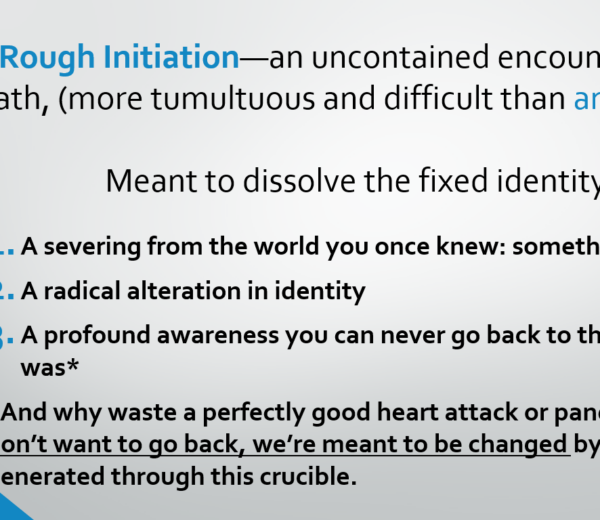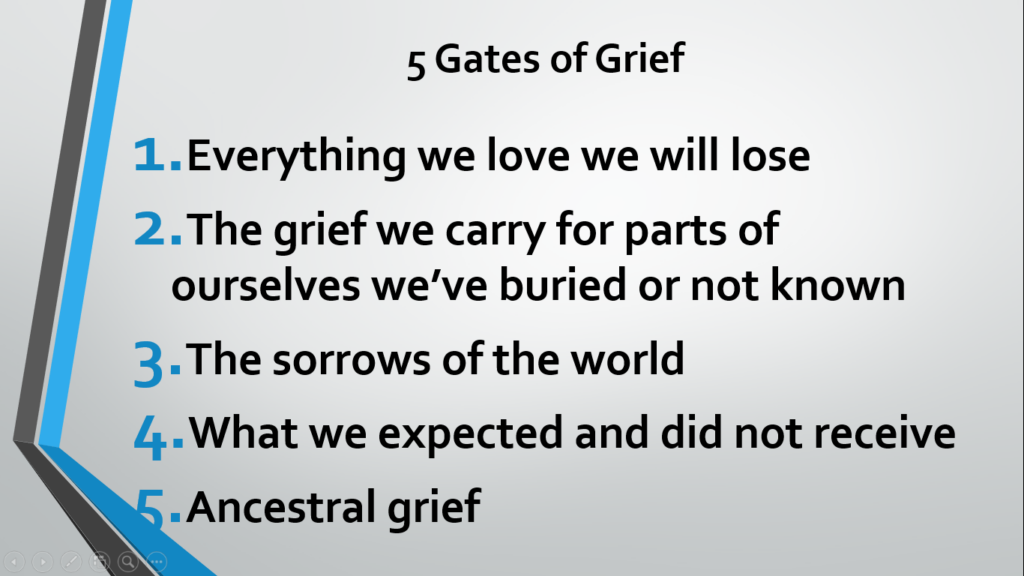
Below is an older and new blog post about the 8th domain of integration (the brain making sense of time, uncertainty, and mortality) and a link to a related video, just posted on my neuroscience YouTube blog. This post is inviting you to think about what painful experiences in your life have caused you to grow and the tools you learned from those experiences, then how those resources can help you now during the Coronavirus. The terminology of an “initiation” is a way to frame prior painful experiences and think more deeply about them.
APRIL 28, 2020
UPDATE TO THE ORIGINAL POST
Frances Weller writes about grief being a “faculty,” which relates to this skill of achieving the 8th Domain. I emailed him and asked for his definition of the word “faculty,” just to be clear, he replied, “What I mean by faculty, when speaking about grief, is that grief is more than an emotion, it is a core skill, a capacity woven into our psychic and physical being. But like any skill, it can become dulled, deadened through neglect. The natural response to loss, is sorrow. Self-consciousness, shame, feelings of not mattering, all congest this natural movement and block the expression of this energy. To relearn this skill, is one of the key invitations in this time. Much is dying, is leaving, is suffering. The proper response includes grieving for these losses. I hope this gives you a sense of what I mean by faculty.”
See this 2 minute video where Weller describes his definition of an “initiation,” which is an encounter with death. The writing after the video is what I have written under the video on YouTube :
***UPDATE: Weller is offering a 4 week group on Saturdays in June if you’re interested: https://www.francisweller.net/an-apprenticeship-with-sorrow.html
I wanted to post this description of a “rough initiation” from Frances Weller for people to reflect on the implications for the Coronavirus and any initiations they’ve had or are going through. The original interview is here https://tns.commonweal.org/podcasts/francis-weller/. He has published a new book, “In the Absence of the Ordinary,” that is a collection of essays that I highly recommend, see it here: https://www.francisweller.net/ For those going through grief, here are blog posts of my favorite resources when I was in my deepest sorrows with the death of my husband: https://greenlightheidi.com/2011/07/affirmations-for-grief/ And a meditation known as “strong back, soft front,” here: https://greenlightheidi.com/2011/07/meditation-for-grief/
May we find the inner resources to be present with our sorrow, including all 5 gates outlined by Weller.

May we be honest with ourselves and others about our experiences of suffering and loss. It has been and continues to be a journey for me, not only when losing my husband to brain cancer in 2009 but as I face intense physical pain due to a rare, congenital back condition. Please feel free to make a comment below.
ORIGINAL POST:
If you are grieving and trying to make sense of death…the meaning of life is probably on your mind. It was on my mind when my husband was diagnosed with cancer, throughout his treatment, and still continues long after his death.
Recently, I’ve come across some science on brain health that helped me to understand my grieving process better.
Instinctively, the threat of death (your own or others) can bring up the need to control. This is natural: our brain is wired to seek permanence and continuity. It’s why when we blink, our mind makes it seem like one steady flow, even though it’s NOT.
Yet, besides this instinct, another part of our our brain allows us to contemplate the meaning of death (and life). This part of the brain, primarily located in the prefrontal cortex, deals with more complex reasoning including morality and empathy.
In neurobiology there are nine domains of integration, (see nine domains chart here). Together these are part of the definition of optimal health. (For those who have heard me lecture, in neurobiology “Integration = Health). Temporal integration is the 8th domain out of 9 domains; it is the integration of the two very different brain functions that I just mentioned. Essentially, temporal integration is a coming to peace with the fact that we all want and need certainty yet we also must acknowledge that everything dies.
Temporal integration is the brain making sense of time, certainty and uncertainty, and mortality and immortality.
To mature and reach our full potential, we must learn to live with the inherent uncertainty of being alive. Joan Halifax in her book, “Being with Dying,” calls this practicing “not knowing.” Since the domains are progressive in neurobiology, the skills that come from achieving integration in each domain are required in order to help achieve temporaral integration. One small example is the 2nd domain: bilateral hemispheric integration. When our two hemispheres are well integrated, the corpus callosum, (the bridge that connects the two hemispheres,) contains more integrative fibers. This leads to greater affect regulation, (the ability to calm down strong emotional intensity).** Since grief brings intense emotional intensity, the more someone has bilateral hemispheric integration, the easier it will be to calm down their amygdala and move into reflective states that require higher functions like morality and empathy.
When I’ve co-facilitated grief groups in the past, Mona Taylor, LCSW, has a sentence that to me, represents the thought of a person who is grappling to attain integration: “I am learning to be a vulnerable person in an unpredictable world.” We must possess the ability to calm our emotions, the ability to reflect deeply using executive functions like empathy and insight, and many more skills, before we can truly hold grief in our hearts and minds in a way that becomes both grounded and meaningful. Like the mind in neurobiology, (which is an embodied and relational process that regulates energy and information flow,) grief is a process and I encourage everyone to be gentle with themselves as they work with it. I think it’s like shame, too, in that it is a social emotion and requires an involvement with others as part of the integration process.
I’ll end with an appropriate quote by Pema Chodron:
“We think that the point is to pass the test or overcome the problem, but the truth is that things don’t really get solved. They come together and they fall apart. Then they come together again and fall apart again. It’s just like that. The healing comes from letting there be room for all of this to happen: room for grief, for relief, for misery, for joy.”
By cultivating all nine domains of integration including temporal integration, we are better able to “let there be room for all of this to happen.”
**Note: While trauma shrinks the corpus callosum, loving-kindness meditation grows it* (Research from Naropa Institute, 2004).
I have a $5 recording on bilateral hemispheric integration, it’s like an 18 minute mini science lecture combo guided meditation, email me for info at HeidiCrockett at gmail.com
A final grief resource that I want to mention is opentohope.com, they divide losses by 4 categories (if you’ve lot a child, a parent, etc.) and have lots of personal stories that really touch me.
Making Peace with Grief: Achieving “Temporal Integration”
If you are grieving, trying to make sense about life…and death…is probably frequently on your mind. It was on my mind when my husband was diagnosed with cancer, throughout his treatment, and still continues long after his death.
Recently, I’ve come across some science on brain health that helped me to understand my grieving process better.
Instinctually, the threat of death (your own or others) can bring up the need to control. This is natural: our brain is wired to seek permanence and continuity. It’s why when we blink, our mind makes it seem like one steady flow, even though it’s NOT.
Yet, besides this instinct, another part of our our brain allows us to contemplate the meaning of death (and life). This part of the brain, primarily located in the prefrontal cortex, deals with more complex reasoning including morality and empathy.
Dr. Daniel Siegel names nine domains of integration as part of his definition of optimal mental health. (See chart at the bottom of this page.) One of these domains, known as “temporal integration,” is the integration of the two very different brain functions that I just mentioned. Essentially, temporal integration is a coming to peace with the fact that we all want and need certainty yet we also must acknowledge that everything dies.
Temporal integration is the brain making sense of time, certainty and uncertainty, and mortality and immortality.
To mature and reach our full potential, we must learn to live with the inherent uncertainty of being alive. Joan Halifax in her book, “Being with Dying,” calls this practicing “not knowing.” Since the domains are progressive in neurobiology, the skills that come from achieving integration in each domain are required in order to help achieve temporaral integration. One small example is the 2nd domain bilateral hemispheric integration. Our two hemispheres when well integrated mean the corpus callosum, (the bridge that connects the two hemispheres,) contains more integrative fibers. This leads to greater affect regulation , (the ability to calm down strong emotional intensity). While trauma shrinks the corpus callosum, loving-kindness meditation grows it* (Research from Naropa Institute, 2004).
When I’ve co-facilitated grief groups in the past, Mona Taylor, LCSW, has a sentence that to me, represents the thought of a person who is grappling to attain integration: “I am learning to be a vulnerable person in an unpredictable world.” We must possess the ability to calm our emotions, the ability to reflect deeply using executive functions like empathy and insight, and many more skills, before we can truly hold grief in our hearts and minds in a way that becomes both grounded and meaningful. Like the mind in neurobiology, which is an embodied and relational process that regulates energy and information flow, grief is a process and I encourage everything to be gentle with themselves as they work with it. I think it’s like shame, too, in that it is a social emotion and requires others as part of the integration process.
I’ll end with an appropriate quote by Pema Chodron:
“We think that the point is to pass the test or overcome the problem, but the truth is that things don’t really get solved. They come together and they fall apart. Then they come together again and fall apart again. It’s just like that. The healing comes from letting there be room for all of this to happen: room for grief, for relief, for misery, for joy.”
By cultivating all nine domains of integration including temporal integration, we are better able to “let there be room for all of this to happen.”
APRIL 28, 2020
UPDATE TO THE ABOVE ORIGINAL POST
Frances Weller writes about grief being a “faculty,” which relates to this skill of achieving the 8th Domain. See this 2 minute video from my neuroscience blog where Weller describes his definition of an “initiation,” which is an encounter with death. My description from below the YouTube video is pasted below :
I wanted to post this description of a “rough initiation” from Frances Weller to put out into the world for people to think more deeply about the implications for the Coronavirus. The original interview is here https://tns.commonweal.org/podcasts/f…. He has published a new book, “In the Absence of the Ordinary,” that is a collection of essays that I highly recommend, see it here: https://www.francisweller.net/ For those going through grief, Crockett has some blog posts with helpful affirmations: https://greenlightheidi.com/2011/07/a… And a meditation known as “strong back, soft front,” here: https://greenlightheidi.com/2011/07/m…
May we find the inner resources to be present with our sorrow, including all 5 gates outlined by Weller. May we be honest with ourselves and others about our experiences of suffering and loss. It has been and continues to be a journey for me, not only when losing my husband to brain cancer in 2009 but as I face intense physical pain due to a rare, congenital back condition. Please feel free to make a comment below.
Questions? Contact me at
HeidiCrockett at gmail.com
*** “control” photo credit to faramarz
***”Share your happiness with others” fortune cookie photo credit to Tim Ebbs
For more acute grief, please read post 1 and post 2.
I end post 2 with the quote, “The place in your body where these two meet—strong back and soft front—is the brave, tender ground in which to root our caring deeply when we begin the process of being with dying.” (p.17)
But what about the “brave. tender ground” when we are at the two year or the five year anniversary of our loss? I always say to clients who are experiencing grief that grief is like bad weather, like a cloudy, stormy day. As a person, you experience bad weather and in a way, other than staying under the covers, there is little you can do but hear it as it passes and feel.
I think having an attitude where you see your grief like bad weather helps to reduce the resistance to the potentially strong feelings, so they may arise…and with time, pass. I have seen grieving clients get EKGs (multiple, over months) due to “chest pain” and the EKGs come back normal. The anxiety and pain of grief is REAL. I often say to clients that the body grieves. Someone close to us dies and the pain of the loss filters through us. We lose our appetite. We overeat. We go out and do crazy things. We never want to leave the house. Do remember, no matter the thoughts involved or the physical symptoms, grief has an impersonal element to it. It happens to us, through us, and for us….kind of like the death of our loved one “happened” one day.
TIPS:
1. Find support
2. Do your best to relax into the pain and feel it without shame
ON THE OTHER SIDE:
It’s been over three years since I lost my husband, Roger. Research shows that successful “grief resolution” typically involves meaning-making which is what I did by going back to get my Masters degree. I took the pain of grief and used it in a practical way (attending school) in my life. Of course it helped me to move to a new town and getting rid of old things.
The bad weather comes but less often. I can think more fondly of my time with Roger, rather than feel the heaviness that surrounded his care closer to the end of his life. I tell people that I LOVE the illusion of permanency that fills my life. For me, I don’t forget that it’s an illusion and that death comes to us all. Sometimes I watch mothers with infants and I marvel at the risk inherent in love. How else could we go on living our lives so completely but by pushing away the idea and reality of death? When one is grieving, whether it is chronic or acute, the perspective is different than others. It is good to acknowledge this.
Honestly, I have moments where I struggle to find meaning in life. (I know that one doesn’t have to be “experiencing grief” to have this struggle.) Usually, I say to myself, “I make the meaning that is my life,” thus making it up to me to invest my time in people and experiences so that I can feel the connection that is life. That is the story that I carry today. And I know that it’s a story.
On the other side, what I am settling into is a meaningfulness that is self-created. Here, I take greater and greater responsibility for the time that I have left to be alive. I do not numb with sugar or alcohol or things. I did once and we do what we need to do to survive. I am ever-simplifying my life so I can come closer and closer to living my values, clarifying my goals, and completing them in whatever time it takes to complete them. I am getting better about not rushing, which was a big habit for me.
Remember, grief is an incredible journey that brings gifts on the other side. (It can totally suck along the way though.) We often underestimate the value of grief when it arises in our lives. (It is the same with sickness.)
Readers response:
“Are you kidding me, Heidi?! You’re saying I should be GRATEFUL that my son is dead???? Really???!!!”
I’m not saying how anyone should feel. I’m saying that on the other side of grief, once I have cried to completion and bathed in the love that comes through the nourishment inherent in life, I feel gratitude for everything including death. Yes, I lost someone that I loved deeply, but I have so many others around me now! I think that because I sat with my bad weather for long enough, I was finally able to “bury” Roger and find new ways to give and receive love in my life.
Grief is mysterious. Everyone’s journey is unique. How we make peace with our loss and meaning out of the pain is SUPER individualistic. My hope is that what I write here may provide insight or hope. When I was really lost, what mattered the most were the people that loved me…the hospice grief counselor, (Jan,) my acupuncturist, my mom, Donna Cottle, who took Roger out every week so that I could have a few hours alone…the research calls this my “social support network,” I call it my lifeline. And it keeps happening, even though I’ve moved twice and find myself with new people.
Questions? Contact me at
[email protected]
Remember, I want to help you live the healthiest life possible! –GreenLightHeidi
My hope is that anyone experiencing deep grief can somehow encounter my “grief toolkit” here. I am going to list the tools that I used as I was with my husband, Roger, during his cancer diagnosis. These tools aren’t a panacea for grief. The truth is that, quite possibly, if you are the grieving person, the emotions that you are experiencing are the most intense and painful that you have ever known. This can be if you are grieving the actual loss of a person, a pet, anticipating the loss of someone, or undergoing the loss of a relationship or a job. There are so many ways that we experience loss, yet oftentimes we don’t understand our own coping mechanisms (or what we can do) when the pain hits.
All phrases are from Joan Halifax’s “Being with Dying: Cultivating Compassion and Fearlessness in the Presence of Death“. She is amazing and the book is amazing. I read it over and over and over when Roger was facing the end of his life.
My personal favorites:
1. May I be honest with myself and others about my experience of suffering and loss.
2. May I find the inner resources to be present with my sorrow.
3. I forgive myself for mistakes made and things left undone.
Phrases for dying person: (p.162)
1. May I accept my anger, fear, and sadness, knowing that my heart is not limited by these feelings.
2. May all those I leave behind be safe and peaceful.
3. May I remember my consciousness is much vaster than this body as I let go of this body.
4. May I be open to the unknown as I leave behind the unknown.
5. May I live and die in ease.
Phrases for caregivers: (p. 100)
1. May my love for others flow boundlessly.
2. May the power of loving-kindness sustain me.
3. May I find the inner resources to truly be able to give.
4. May I remain in peace and let go of expectations.
5. May I offer my care and presence unconditionally, knowing it may be met by gratitude, indifference, anger, or anguish.
6. May I offer love, knowing that I cannot control the course of life, suffering, or death.
7. May I see my limits compassionately, just as I view the suffering of others.
8. May I accept things as they are.
Questions? Contact me at
[email protected]

My hope is that anyone experiencing deep grief can somehow encounter my “grief toolkit” here. I am going to list the tools that I used as I was with my husband, Roger, during his cancer diagnosis. These tools aren’t a panacea for grief. The truth is that, quite possibly, if you are the grieving person, the emotions that you are experiencing are the most intense and painful that you have ever known. This can be if you are grieving the actual loss of a person, a pet, anticipating the loss of someone, or undergoing the loss of a relationship or a job. There are so many ways that we experience loss, yet oftentimes we don’t understand our own coping mechanisms (or what we can do) when the pain hits.
***You can hear the Strong Back, Soft Front meditation listed below by clicking here and listening to the podcast at minute 18:30.***
Strong Back, Soft Front—especially good for caregivers
This meditation is from Joan Halifax’s “Being with Dying: Cultivating Compassion and Fearlessness in the Presence of Death“. (All quotes and page numbers are from Joan Halifax’s book. She is amazing and the book is amazing. I read it over and over and over when Roger was facing the end of his life.)



